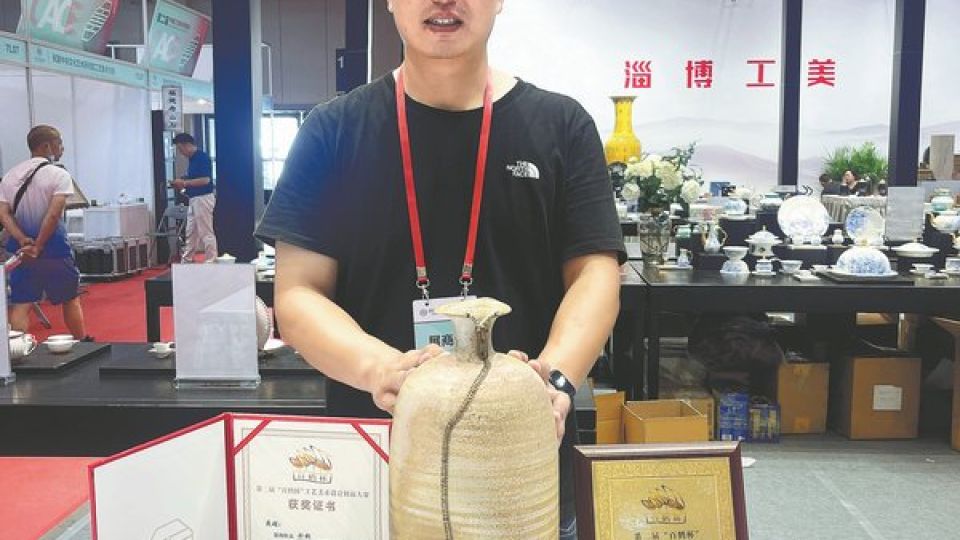March 27, 2023
BEIJING – A zipper runs along a 40-centimeter-tall porcelain vase, with its top slightly open. The art piece, not originally designed that way, has been repaired by Nie Chao.
Nie, 41, is an inheritor of Zibo-style ceramic-mending from the city in Shandong province. Each tooth of the zipper was handmade and tapped onto the vase by Nie. It took him around a month to finish the work.
He named it Puyun (“appeal of simplicity”), inspired by the traditional Chinese dress, qipao. He has made the static vase look like a movable dress in the wind.
Nie recalls that he found the vase in a broken state at a friend’s house and thought of how to repair it with modern skills.
“The zipper is a modern industrial product, and I thought combining it with our traditional porcelain-repairing techniques would be a good representation of both,” he says.
The repaired vase won Nie the new talent award at the Baihe Cup, an art and craft design and innovation competition, where more than 3,000 pieces or sets of work were shown. The competition was held during the second edition of the China Arts and Crafts Expo in Nanjing, Jiangsu province, in September 2021.
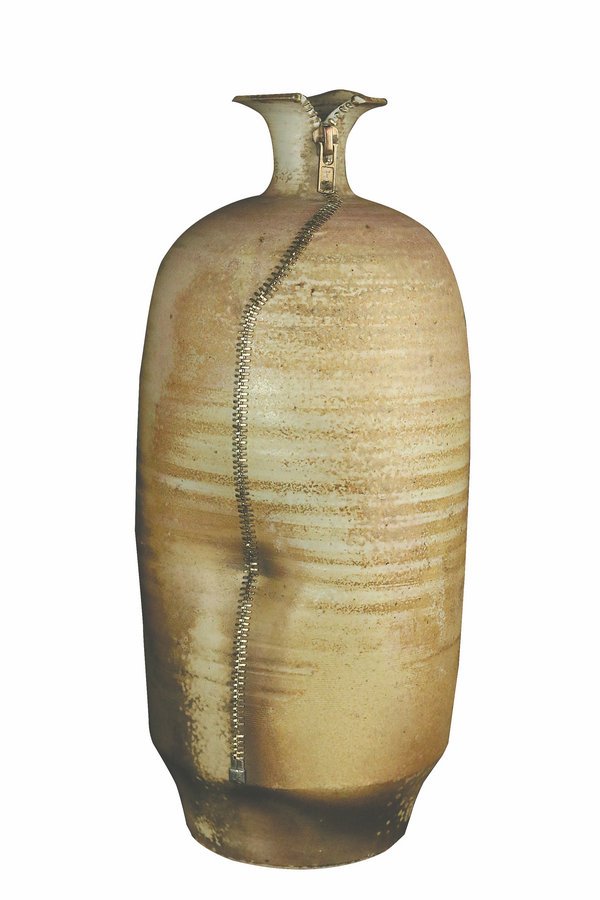
A zipper runs along a 40-centimeter-tall porcelain vase, with its top slightly open. The art piece, not originally designed that way, has been repaired by Nie Chao. [Photo provided to China Daily]

A lid enhanced with traditional engraving. [Photo provided to China Daily]
As the fifth-generation inheritor of his family’s ceramic-repair skills, Nie has devoted himself to better preserving them, as well as bringing traditional Chinese engraving skills and modern art designs to the mix.
Mending ceramics is not only a handicraft but also a “living fossil of folk tradition” that has helped the development of Chinese culture and the recovery of ancient relics.
Yuan Xiaobo, a book editor, has studied how Chinese porcelain-mending spread. He says the technique of using metal as a staple to fix two pieces can be traced back 1,500 years.
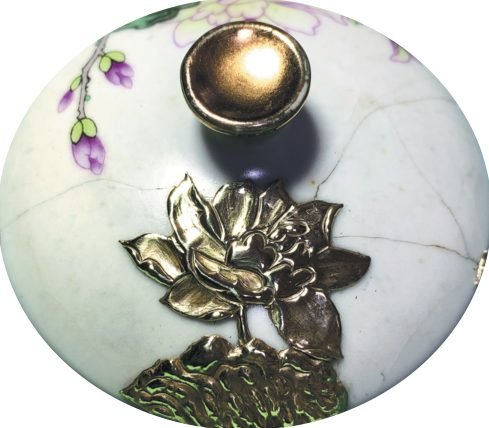
A lotus motif adds depth to the original floral design. [Photo provided to China Daily]
Yuan says the earliest records that mention mending porcelain are in the book Compendium of Materia Medica written by medical expert Li Shizhen of the Ming Dynasty (1368-1644).
Zibo-style porcelain-mending has a history of several hundred years, and focuses on details and precision, especially the method of sticking broken pieces together whereby a shot of metallic powder is added to the fracture so that the finished item is stable.
The technique was added to Shandong’s provincial intangible cultural heritage list in November 2021.
Nie says like regular repair workers and goods dealers, those who knew how to repair ceramics used to also wander the streets with tools.

When Nie works on porcelain, he not only mends but strengthens the piece, as is seen on the teapot lid with a reinforced rim. [Photo provided to China Daily]
Growing up watching his grandfather mending ceramics, Nie has developed a detailed knowledge of the skills. He says, as a child, there were always some people visiting their home, asking his grandfather to repair items such as ceramic cylinders, basins, jars and teapots. When he watched his grandfather restore the broken items to their nearly original state, he felt like he was “witnessing magic”.
Sometimes his grandfather would ask him to give a hand. Gradually, as his grandfather got older, his father took the baton and would help others repair things after work. Nie says his father often told him to learn the technique to continue their family tradition.
“When my grandfather and father were repairing porcelain, they would ask me how I would fix the items. Then they would tell me about the advantages and disadvantages of each idea,” Nie says. “For me, putting the broken pieces together was like playing with building blocks. It was quite fun.”

Nie decorates his work with Chinese characters. [Photo provided to China Daily]
Nie first tried to learn and practice this skill when he was in high school. His father taught him how to drill a hole into a porcelain object — it has to be done at an angle of 85 degrees so that when the staple is put in, it won’t slide out.
When making a hole in a broken piece, Nie had to evaluate its thickness to decide how deep the hole should be to hold the staple while not making a secondary break to the piece. After several trials, Nie successfully stuck two ceramic pieces together with a staple. He still has that piece as a souvenir.

A bat gives a broken tea cup a new look. [Photo provided to China Daily]
Now with decades of practice, Nie can tell whether the hole is deep enough by the sound of drilling.
“We used to make the hole with a diamond by hand, but now with the drill, the size of the hole can be better controlled, and it’s easier to teach others,” he says, adding that the electric drill can make a hole as small as 0.3 millimeters.
Nie says the technique and tools should be preserved.

Nie’s engraved lotus decorates a teapot’s repaired lid. [Photo provided to China Daily]
Due to the availability of modern manufacturing, people prefer to buy a new object instead of repairing a broken one. The need for the skill has become increasingly rare in modern times, yet to repair ceramics, training and practice are needed.
Nie says repairing ceramics is now such a niche field that he can’t even make ends meet. He is making ceramics himself and doing repair work when needed. But he insists on continuing with the traditional skill. He says he hopes to utilize it as a “process of inheritance”, and tell more people how the repair is done, so the technique won’t vanish.
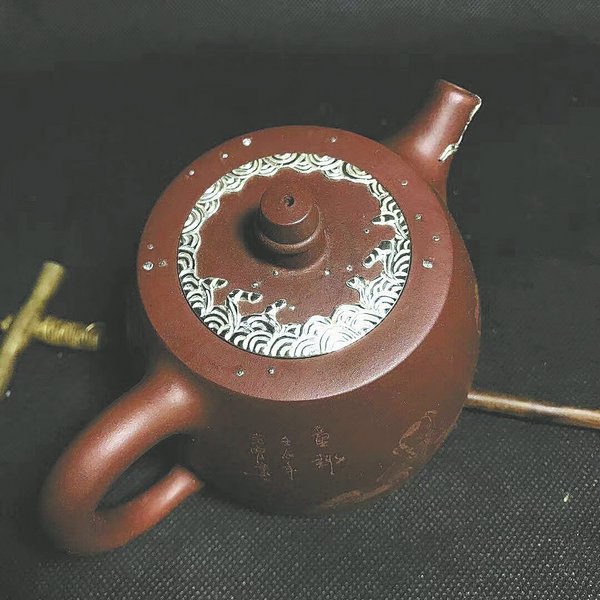
A wave pattern adorns another repaired teapot. [Photo provided to China Daily]
Nie’s father and grandfather were focused on fixing porcelain items to restore their functionality, such as wares that contain water. Nie has taken it a step further as he tries to make the repaired items look even better than the original ones.
He has also learned traditional Chinese engraving, by which he can create intricate relief designs on a metal plate and uses the skill when repairing ceramics. “I hope when seeing the finished products, people don’t think of them as once-broken pieces.”
When he mends a porcelain ware, he not only fixes what’s broken but also strengthens friable parts such as the spout of a teapot.
After many years of practice and exploration, Nie has combined traditional ceramic-repairing techniques with modern art design to help the craft develop further while making it more relevant to daily life.
For example, when mending the broken cover of a teacup, Nie could have just added a couple of metal staples to reconnect the broken parts, but he decided to create a bamboo pattern on it. He also engraved a bat to cover the missing piece of the cup.
Nie says handmade things have one advantage over mass-produced items, in that each is unique. Mending ceramics not only restores the appearance and functionality of a ware but also preserves its historical and cultural value.
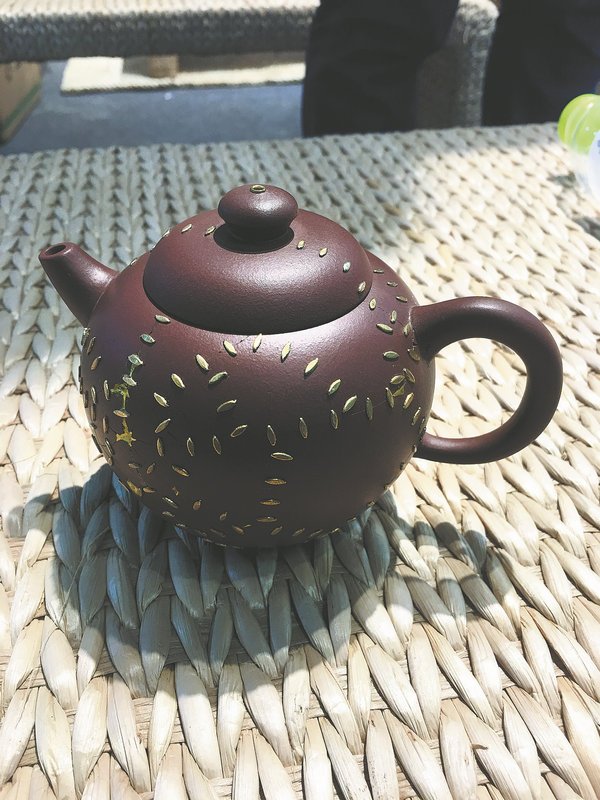
Nie Chao uses handmade metal staples to bind the repaired object. [Photo provided to China Daily]


